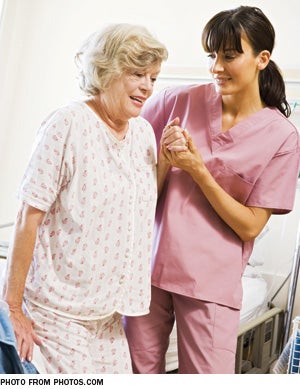Fall prevention takes on greater urgency as hospital patient population ages

Due to its complexity, preventing patient falls always has been a challenge for hospitals and other health care facilities. Now, with the steady increase in aging baby boomers requiring hospitalization, the need to reduce falls has taken on added significance.
Plus, the Affordable Care Act imposes Medicare payment penalties on the
25 percent of hospitals with the highest rates of health care-associated conditions (HACs), including injuries caused by falls.
"Each year, between 700,000 and 1 million people fall while in the hospital, so this is a major patient safety concern," says William Spector, senior social scientist, Agency for Healthcare Research and Quality.
The Joint Commission estimates that the additional costs related to caring for a patient who suffers a serious fall-related injury is more than $13,000 and adds about six days to the patient's length of stay. In 2008, the Centers for Medicare & Medicaid Services stopped paying reimbursements to hospitals where patients suffered severe injuries due to a fall.
To address the issue, Health & Human Services' Partnership for Patients public-private patient safety initiative has set a goal of reducing HACs by 40 percent by the end of this year, a goal that includes cutting injuries from falls and immobility.
The good news is that health care systems that develop programs focusing on fall prevention can and do reduce rates. Technology and to some extent facility design can aid in the process, according to patient safety experts.
Intermountain Healthcare, Salt Lake City, surpassed the system's fall-reduction goals by implementing a series of measures, many commonly used and with a strong record of success, says Marlyn Conti, R.N., CPHQ, quality patient safety initiatives manager at Intermountain.
Intermountain formed a 16-member fall-prevention team with clinical and administrative representatives from among its 22-hospital system as a first step to refocus its efforts in tackling the challenge, says Conti, who serves as team leader.
The system's goal was to reduce the number of falls from a baseline of 4.41 falls per 1,000 patient days at the end of 2010 to 4.21 falls per 1,000 days by the end of 2011. The results surpassed the goal as the system achieved a rate of 3.42 falls per 1,000 patient days, she says.
How did they do it? "It's availability of data, leadership focus and, in terms of specifics, there are lots of little things that go into the prevention protocol," Conti says.
Among those "little things" implemented are:
- Assessing patient risk for falls upon admission and daily.
- Engaging all staff and patients in the prevention process.
- Scheduling rounding protocols to check on patient condition.
- Emphasizing safe patient handling through the use of gait belts and lifts.
- Designing patient rooms to minimize fall risk through things like smart placement of electrical outlets and bathroom tissue dispensers.
Technology is taking on an important role, too. Conti says Intermountain Healthcare utilizes bed sensors that sound an alarm to notify nurses that a patient is getting out of bed or already out.
Kaiser Permanente, Oakland, Calif., is evaluating use of the same technology and others, too, says Lisa Schilling, vice president, Healthcare Performance Improvement, at Kaiser's Center for Health System Performance.
The health care system is looking at the use of real-time location systems that include ultrasound sensors in patient rooms and hallways that track location of the patient within the room.
Kaiser is also evaluating the use of virtual bed rails that use cameras to detect if fall-risk patients are trying to get out of bed and alert staff when necessary. Other technologies that can detect agitated movement by patients in bed are also in development, she says.
While technology can help, fall prevention requires a multifaceted approach, acknowledge Schilling and other patient safety experts.
"We are leveraging multipronged pathways to accelerate our fall prevention efforts to support clinical practice, improve quality, ensure safety and reliability and, ultimately, enhance care to our patients," Schilling says.




